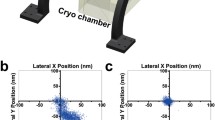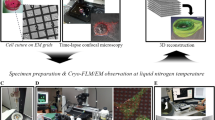Abstract
The cell nucleus is a crowded volume in which the concentration of macromolecules is high. These macromolecules sequester most of the water molecules and ions which, together, are very important for stabilization and folding of proteins and nucleic acids. To better understand how the localization and quantity of water and ions vary with nuclear activity, it is necessary to study them simultaneously by using newly developed cell imaging approaches. Some years ago, we showed that dark-field cryo-Scanning Transmission Electron Microscopy (cryo-STEM) allows quantification of the mass percentages of water, dry matter, and elements (among which are ions) in freeze-dried ultrathin sections. To overcome the difficulty of clearly identifying nuclear subcompartments imaged by STEM in ultrathin cryo-sections, we developed a new cryo correlative light and STEM imaging procedure. This combines fluorescence imaging of nuclear GFP-tagged proteins to identify, within cryo ultrathin sections, regions of interest which are then analyzed by STEM for quantification of water and identification and quantification of ions. In this chapter we describe the new setup we have developed to perform this cryo-correlative light and STEM imaging approach, which allows a targeted nano analysis of water and ions in nuclear compartments.
Access this chapter
Tax calculation will be finalised at checkout
Purchases are for personal use only
Similar content being viewed by others
References
Hancock R (2014) The crowded nucleus. In: Hancock R, Kwang J (eds) New models of the cell nucleus: crowding, entropic forces, phase separation, and fractals, vol 307, Int Rev Cell Mol Biol., pp 15–26
Ball P (2008) Water as an active constituent in cell biology. Chem Rev 108:74–108
Terryn C, Michel J, Killian L et al (2000) Comparison of intracellular water content measurements by darkfield imaging and EELS in medium voltage TEM. Eur Phys J Appl Phys 11:215–226
Delavoie F, Molinari M, Milliot M et al (2009) Salmeterol restores secretory functions in cystic fibrosis airway submucosal gland serous cells. Am J Respir Cell Mol Biol 40:388–397
Briegel A, Chen S, Koster AJ et al (2010) Correlated light and electron cryomicroscopy. Methods Enzymol 481:317–341
Sartori A, Gatz R, Beck F et al (2007) Correlative microscopy: bridging the gap between fluorescence light microscopy and cryoelectron tomography. J Struct Biol 160:133–145
Schwartz CL, Sarbash V, Ataullakhanov F et al (2007) Cryofluorescence microscopy facilitates correlations between light and cryoelectron microscopy and reduces the rate of photobleaching. J Microscopy 227:98–109
Van Driel LF, Valentijn JA, Valentijn KM et al (2009) Tools for correlative cryofluorescence microscopy and cryoelectron tomography applied to whole mitochondria in human endothelial cells. Europ J Cell Biol 88:669–684
Rigort A, Bäuerlein FJB, Leis A et al (2010) Micromachining tools and correlative approaches for cellular cryoelectron tomography. J Struct Biol 172:169–179
Nolin F, Ploton D, Wortham L et al (2012) Targeted nano analysis of water and ions using cryocorrelative light and scanning transmission electron microscopy. J Struct Biol 180:352–361
Nolin F, Michel J, Wortham L et al (2013) Changes to cellular water and element content induced by nucleolar stress: investigation by a cryocorrelative nano-imaging approach. Cell Mol Life Sci 70:2383–2394
Kanda T, Kevin F, Sullivan KF et al (1998) Histone–GFP fusion protein enables sensitive analysis of chromosome dynamics in living mammalian cells. Curr Biol 8:377–385
Zierold K (1986) The determination of wet weight concentrations of elements in freeze-dried cryosections from biological cells. Scan Electron Microsc 2:713–724
Acknowledgments
We acknowledge funding from the Agence Nationale pour la Recherche (ANR-07Nano-CESIWIN), INSERM (Physicancer program: Noci-cytox), and Région Champagne Ardennes and technical support from the PICT IBiSA Biological Imaging Center from URCA University.
Author information
Authors and Affiliations
Corresponding author
Editor information
Editors and Affiliations
Rights and permissions
Copyright information
© 2015 Springer Science+Business Media New York
About this protocol
Cite this protocol
Nolin, F. et al. (2015). Targeted Nano Analysis of Water and Ions in the Nucleus Using Cryo-Correlative Microscopy. In: Hancock, R. (eds) The Nucleus. Methods in Molecular Biology, vol 1228. Humana Press, New York, NY. https://doi.org/10.1007/978-1-4939-1680-1_12
Download citation
DOI: https://doi.org/10.1007/978-1-4939-1680-1_12
Published:
Publisher Name: Humana Press, New York, NY
Print ISBN: 978-1-4939-1679-5
Online ISBN: 978-1-4939-1680-1
eBook Packages: Springer Protocols




